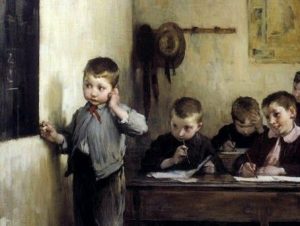What is a Method of Teaching English as a Second Language, Approach, Design, and Procedure?
I wrote this article to try to explain every famous ESL method. Before writing this article I read and based myself on Richards and Rodgers (1986) book “Approaches and Methods in Language Teaching”. In it, they check many methods and present the idea that almost all language teaching methods follow the same logic. As a result a thorough analysis into their nature is necessary for every ESL teacher. Read more.
The Classical Method
The first ESL method appeared well before English had the influence it has today. During the Late Middle Ages, people used to learn Latin and ancient Greek in schools. The study of these languages was done in a very amateur way. Every teacher had its own way and its own idea of how teaching happened. Consequently there was no agreement or exchange of experiences between teachers. The teaching of ESL started in the 17th century, due to trade in the English Channel. Read more.
Grammar-Translation Method
The Grammar-Translation method is one of the most famous ESL methods that exist. It evolved from the Classical Method that was used in the teaching of Latin and Greek and because of that, this method focuses on literature and grammar of the L1. It rely heavily on the translation of passages from relevant books. Read more.
The Direct Method
The Direct method of teaching has a very interesting history, and you should read the whole article. This method is sometimes called the natural method. This method is very strict and it prohibits the student to use the L1 in the classroom. It focuses a lot on everyday spoken language, as well as in associating meaning directly in English. Read more.
Audio-Lingual Method
The audio-lingual method, or Army Method, or New Key, is based on behaviorist theory, and because of that it postulates that humans could be trained through a system of reinforcement. Listening and speaking drills and pattern practice only in English. Read more.
Cognitive Grammar Approach
Cognitive grammar is an approach developed by Ronald Langacker, which hypothesizes that grammar, semantics, and lexicon exist on a continuum instead of as separate processes altogether. This approach to language was one of the first projects of cognitive linguistics. Read more.
The Audio Visual Method
The audiovisual method was first developed in France in the 1950s. This method is intended for teaching everyday language at the early stage of second/foreign language learning. It was based on a behaviourist approach, which held that language is acquired by habit formation. Read more.
The Bilingual Method
C.J. Dodson (1967) developed The Bilingual Method in 1967 as a counterpart of the audiovisual method. In both methods the preferred basic texts are dialogues accompanied by a picture strip. The bilingual method, however, advocates two revolutionary principles based on the results of scientifically controlled experiments in primary and secondary schools. Read more.
The Communicative Language Teaching
Of Every ESL Methods, the Communicative language teaching (CLT), or communicative approach, is a concept that language learning occurs when the teacher gets learners to see the language pragmatically to mediate meanings for a purpose, to do things which resemble in some measure what they do with their own language. Read more.
The Lexical Syllabus
This method focuses itself on chunks. Chunks are groups of words that can be found together in language. Chunks include lexical phrases, set phrases, and fixed phrases such as ‘by the way’, ‘at the end of the day’. In this method students are taught to be able to notice patterns of language (grammar) as well as have meaningful set uses of words at their disposal. Read more.
The Natural Approach
Stephen Krashen and Tracy Terrell developed the Natural Approach in the late 1970s. It claims that language learning is a reproduction of the way humans acquire their first language. The focus on grammar is decreased and corrections of student’s mistakes is increased. The speaking part is delayed until the student feels comfortable. Hence, meaning clarified through actions and visuals. Read more.
The Structural Approach
Structural Approach is a technique that the learner masters the pattern of sentence. Therefore, it is based on the assumptions that language can be best learnt through a scientific selection. And, grading of the structures or patterns of sentences and vocabulary. By teaching learners to know the forms of the language as a medium and the meaning they incorporate; that they will learn how to do things with this knowledge on their own. Read more.
The Silent Way
Caleb Gattegno developed the Silent Way method. In this method the teacher stays quiet most of the time while encouraging the students to talk. The method is based on the ideas from a book from 1963. As it is from the 1960s and 1970s is a break from the hard core past to a more understanding future. The method tries to bring to light some new aspects that weren’t thought as fundamental to language learning before Read more.
Suggestopedia
Georgi Lozanov developed Suggestopedia, and the main idea of it is to speed up learning. It works by de-suggestion of psychological barriers and positive suggestion. Relaxed atmosphere, with music; encourages subliminal learning of English . Read more.
Community Language Learning
Of Every ESL Methods, this is an approach in which students work together to develop what aspects of a language they would like to learn. Counselling-approach is based on the idea that the teacher acts as a counselor. The student is the “client” or “collaborator”. Understanding of English through active student interaction. Read more.
Total Physical Response
James Asher developed the Total Physical Response language teaching method. It is based on the coordination of language and physical movement. Read more.
Content-based Instruction
Content-based Instruction focuses on the lesson itself, not the language. The exercises are the focus and not the English language. The focus is on the task, making the language a medium in which the task is performed. Content based on relevance to students’ lives: topics, tasks, problem-solving. Read more.
Learning Strategy Training
Learning Strategy Training is based on problems that students encounter in the process of learning target language. Teach learning strategies, cooperation; activities vary according to different intelligences. Read more.
Cooperative Learning
Cooperative Language Learning (CLL), also known as Collaborative Learning (CL) is part of the Instructional Approach. This English Teaching Method is an approach to teaching that makes maximum use of cooperative activities involving pairs and small groups of learners in the classroom. Read more.
Multiple Intelligences Emerging Uses of Technology in Language Teaching

Computer-assisted Language Learning or CALL consists of all the programs and websites dedicate to language learning. Electronic Text Corpora is a good example of it. These programs store collections of written and sometimes spoken language, that come in a transcript form or texts. CALL also includes language apps as well as online classes. YouTube videos with ESL teachers are nowadays one of the biggest parts of CALL. Read more.
Ernesto’s Method
This is my method of ESL teaching, and that is why it brings a lot of my own experiences in the classroom to life. In it, I try to solve some of the issues that I frequently noticed in some methods that I was assign to use it. It is a classroom method, which focuses on first grade students. I try to present the content on simple constructions. The constructions use the most common verbs, nouns and adjectives found in the assigned reading books for the school-year. The idea is that students learn L2 by creating memories within each word and as the frequency occurrence of that word increases stronger the memories become. It uses corpora and creativity to incorporate the most frequent words into constructions (sentences). Read more.
What does it take to become an English Second Language teacher?
If you enjoyed this page, check out my Youtube channel for more info on ESL Methods.


